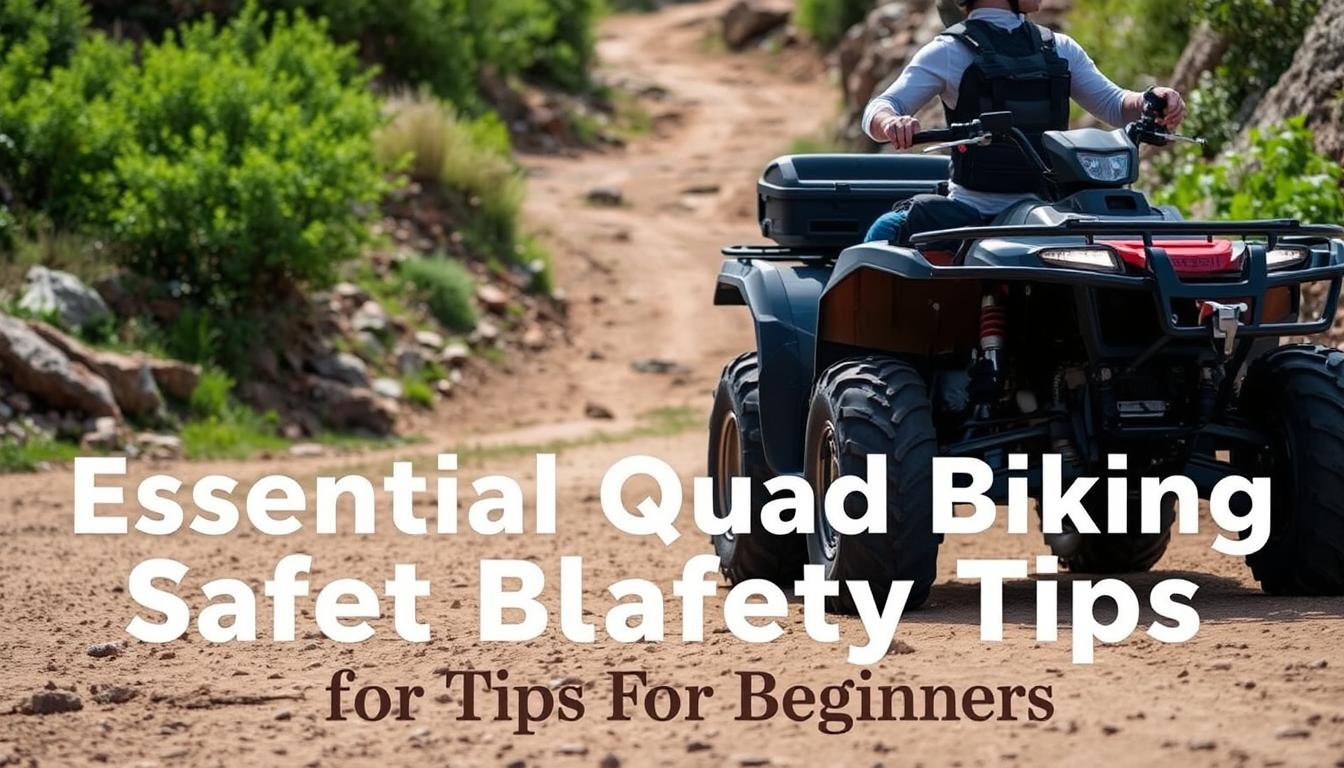
- 85 Views
- 17 Min Read
- (0) Comment
Feel the wind against your face, the excitement of moving through dunes, and being in the wild. Your first time quad biking in Dubai’s deserts can be thrilling. Yet, keeping safe is most important. ATV safety tips are crucial. They make sure your four-wheel adventure is safe. Whether alone or with a group tour by Desert Buggy Rental Dubai, knowing quad biking for beginners makes the trip adventurous and safe.
Getting ready means more than knowing how to use the ATV. It means respecting the machine, surroundings, and yourself. These beginner quad biking safety tips aren’t there to limit fun. They’re there to boost it by bringing confidence and control. So, let’s prepare for a memorable and safe quad biking start.
Key Takeaways
- Understanding safety is crucial for a thrilling yet secure quad biking experience.
- Familiarize yourself with beginner quad biking best practices before you hit the sands.
- Finding the balance between exhilaration and caution can enhance your ride.
- Desert Buggy Rental Dubai tours emphasize the importance of safety protocols.
- Confidence on the ATV comes from respecting the equipment and oneself.
Understanding the Basics of Quad Biking
Quad biking is an exciting adventure that begins with knowing the basics. Whether you’re cruising through forests or conquering the dunes in Dubai, getting familiar with quad bikes will improve your riding skills and keep you safe off-road.
The Different Types of Quad Bikes
Quad bikes, also known as ATVs, vary in design for different uses and landscapes. They mainly fall into these categories:
- Utility ATVs: These are strong and designed for work, not just fun. They can move across tough lands with heavy loads.
- Sport ATVs: These are for speed lovers. They’re light and move quickly over rough areas.
- Side-by-Side ATVs: These have extra seats for passengers, combining performance with comfort. They’re great for family outings in open spaces.
Choosing the right ATV depends on what you want to do with it. This ensures you get the best advice for your activities.
Quad Biking Controls and Functions
To ride safely and confidently, understanding the controls is key. Here’s a quick guide:
| Control | Function |
|---|---|
| Throttle | Manages the ATV’s speed. |
| Brakes | Stops or slows the bike, with separate controls for the wheels. |
| Clutch | Connects or disconnects the engine power to the wheels, common in manual ATVs. |
| Gear Selector | Picks the right gear for the speed or power you need. |
Knowing how to use these controls well is crucial for handling your ATV and staying safe on off-road adventures.
Quad Biking Safety Tips Every Beginner Should Know
Starting your first quad biking journey is thrilling, yet safety must be a top priority. Desert Buggy Rental Dubai stresses that sticking to safety tips for quad biking ensures fun and safety from risks. Here’s what every beginner needs to know about quad biking safety.
First, knowing what your quad can and can’t do is key to staying safe. Being able to handle your bike on different grounds helps avoid accidents. It’s also vital to wear the right safety gear and check your bike before riding.
| Safety Equipment | Importance | Typical Use |
|---|---|---|
| Helmet | Protects against head injuries | Mandatory on all rides |
| Gloves | Improves grip and hand protection | Recommended for all riders |
| Elbow and knee guards | Protects joints during falls | Advised for rough terrain |
Apart from personal prep, knowing your surroundings is also crucial for quad biking safety. Ride safely, watch out for others, and avoid obstacles. Include a safety kit with a first aid box and tools in your gear, preparing you for any scenario.
By following these safety tips for quad biking, your start in quad biking will be both fun and safe. Remember, the excitement of riding should never outweigh the value of safety measures.
Choosing the Right Quad Bike for Beginners
Starting your quad bike adventure means picking the right ride. For newbies, choosing your first quad bike is key. It affects how safe and fun your rides will be. Knowing about the bike’s size, power, and must-have features makes shopping or renting easier. Tips always highlight matching the bike’s power with your skills.
Size and Power Considerations
As a beginner, it’s smart to pick a bike that suits your strength and skill. Opting for a bike that’s too powerful can be tough to manage. The bike’s engine size, in cubic centimeters (cc), shows its strength. For newcomers, bikes in the 200cc to 350cc range are best. They’re exciting yet manageable.
Features to Look For in a Starter Quad Bike
| Feature | Importance | Description |
|---|---|---|
| Automatic Transmission | High | Makes handling the bike easier, letting you focus on riding, not shifting gears. |
| Low Seat Height | Medium | Boosts control and stability by lowering the bike’s center, which makes getting on and off the bike easier for beginners. |
| Electric Start | Medium | Starts the bike easily and reliably, which is a big help for new riders. |
Using these tips to choose your first quad can greatly improve how much you enjoy this exciting activity. You should look for a bike that suits not just your size, but your level of experience too. This way, your quad bike adventures will be safe and fun.
The Importance of Wearing Protective Gear
For beginners in quad biking, the need for proper protective gear is huge. It’s vital for safety, beyond comfort or performance. Safety gear is a big part of ATV riding tips.
Let’s start with the most important safety item:
Helmet: Your Number One Priority
Choosing the right helmet is key for beginners in quad biking. It lowers the chance of bad head injuries if you crash. Make sure your helmet is approved by safety experts and fits right, letting you see well and move your head.
Additional Protective Gear: Gloves, Boots, and Goggles
Besides helmets, gloves, boots, and goggles are also very important. They protect you from many dangers.
| Protective Gear | Function | Importance |
|---|---|---|
| Gloves | Protects hands from abrasions and improves grip | Essential for hand safety and control maintenance |
| Boots | Shields feet and ankles from impacts and provides stability | Crucial for lower body protection and support |
| Goggles | Protects eyes from debris and improves vision clarity | Important for visual clarity and eye protection |
Altogether, these items, along with a helmet, make a full-body safety set. It’s key for anyone, especially new riders. Remember, buying good quality safety gear means you’re looking out for your own safety and future in quad biking.
Pre-Ride Safety Inspection Checks
Checking your quad bike before a ride is key for your safety. A good pre-ride check helps stop accidents and makes your quad biking better. Here’s a checklist that covers important stuff like tires, wheels, brakes, and controls.
- Look at the tires for wear or damage, like cuts, punctures, or bulges. The tread depth should be legal.
- Use a gauge to check tire pressure. Right pressure is vital for performance and safety.
- Check that all wheels are tight. Loose wheels are risky, especially on rough ground.
Inspecting Brakes and Controls
- Try the brake lever and pedal to see if they’re quick to respond. They shouldn’t be spongy or loose.
- Look at the brake pads for wear. If they’re too worn, replace them to stop well.
- Check all controls like the throttle, clutch, and gears. They should move smoothly.
Following these quad biking safety rules keeps your bike in great shape and lowers accident risks. Safety tips for quad biking start with pre-ride checks. Keep this list close, and make sure your quad bike is safe and exciting for your ride.
Getting Familiar with Quad Biking Controls
When starting with quad biking, learning about the controls is very important. This knowledge helps you ride better and safer on rough paths. You’ll become more confident as you get the hang of each part of the bike’s controls.
Throttle and Brakes: These parts help you control your quad bike’s speed. You’ll find the throttle on the right handlebar for speeding up. The brakes are on both handlebars to slow down or stop. Learning to use the throttle and brakes smoothly is key for a safe ride.
Gear Shifters: Knowing how to use the gears is vital, whether your bike has manual or automatic gears. With manual shifters, you’ll change gears using your foot and a clutch. Automatic bikes make this easier. Try using different gears to see what suits your style and the land you’re riding on.
- Check each control before riding.
- Practice with the throttle and brakes where it’s safe.
- Get used to shifting gears smoothly.
Getting to know these controls makes riding an ATV more fun and secure. By learning these basic skills, you’re ready for great times on your quad bike.
Safe Riding Techniques for Beginners
Starting your first quad biking journey is exciting. But, safety should be your top priority. Knowing how to start, steer, and stop is essential. Plus, learning how to handle your weight while riding makes off-roading safer. We’ve got key tips for beginners to enjoy quad biking safely.
First, make sure you’re seated right with your feet on the footrests and hands on the handlebars. To start, turn the key to ‘on’ and check the bike is in neutral. Hit the electric start button if your bike has one. To move, gently push the throttle. When steering, you need small, careful movements to keep your balance. Stopping should be smooth—ease off the throttle and brake gently. If needed, shift down gears to stop completely.
Mastering Balance and Weight Distribution
Staying balanced on a quad bike is about more than sitting up straight. You must shift your body weight based on the terrain and your speed. Lean forward going uphill to avoid tipping backwards. Lean back going downhill. And lean into your turns. Adjusting your weight right is key for safe riding on different terrains.
These basics will improve your skills and keep you safe. Remember, getting good takes practice. So, practice these techniques in a safe area before trying tougher trails.
Understanding and Navigating Different Terrains
Desert Buggy Rental Dubai offers a chance to master diverse landscapes in the United Arab Emirates. Learning to manage different terrains is key for a better quad bike and ATV experience. We’ll show you how to ride on sand and tackle hills and bumpy surfaces.
Riding on Sand: Tips and Tricks
Riding on sand with an ATV or quad bike is not like riding on solid ground. Wheels might sink or slide because the sand is loose. Lower your tire pressure to improve grip by increasing the tire’s touch on the sand. Keep your speed steady. Going too fast or too slow can cause problems. Use the momentum to move smoothly over the sand.
Handling Hills and Uneven Surfaces
Hills and bumpy terrains need good skills and focus. Always face hills directly, not at an angle, to reduce the chance of flipping. Look ahead and pick the easiest path up the hill. Lean forward when going up to help with front wheel grip. When going downhill, lean back to keep the bike stable. Keeping your speed even and your grip relaxed helps in adjusting quickly to the terrain.
Using these quad bike riding tips and ATV riding tips during practice will greatly boost your confidence in tough terrains. Remember, practice leads to perfection. The more you practice, the better you become at navigating these challenges.
Speed Management and Braking
Learning how to manage speed and brake well makes quad biking safety better. This helps you ride smoothly and lowers accident risks. Beginners need to learn changing speeds based on the terrain and braking right to stay in control.
Riding on different surfaces means adjusting your speed. This is a key safety tip for quad biking. Fast on bumpy ground might make you lose control. Going too slow on slopes might stop your bike. So, knowing how to change speed is key.
| Terrain Type | Recommended Speed | Braking Tips |
|---|---|---|
| Flat, firm surfaces | Moderate to high | Use gradual braking; avoid sudden stops |
| Sandy or loose surfaces | Low to moderate | Brake early, keep a steady hand |
| Hilly or steep areas | Low | Use engine-braking along with your brakes |
Learning these skills is good for being safe and improving your riding. Practice in various conditions to get better. With more experience, you’ll be quick to decide how to speed and brake right for quad biking safety. Always keep safety first when you’re on an adventure.
Rules of the Trail and Environmental Considerations
Going out to quad bike in the wild needs careful thought. It’s important to keep ATV safety and green riding habits in mind. This way, you get to have fun and still keep nature beautiful for others.
First, knowing the trail rules keeps you and everyone else safe. Next, using eco-friendly ways helps keep the land unspoiled.
Respecting Trail Etiquette
Following trail rules helps everyone get along. Stick to marked paths to lessen your effect on wildlife and their homes. Letting other riders pass in tight spots and not speeding keeps accidents low and nature undisturbed.
Promoting Sustainable Riding Practices
Eco-friendly quad biking means less harm to the environment. Stick to known trails, steer clear of delicate or off-limits areas, and take your trash with you. These actions safeguard plants and animals and keep trails ready for future riders.
Every quad biker must stick to these rules and inspire others to do the same. This way, we all help preserve the joy of quad biking and the beauty of nature.
Preventing Common Quad Biking Injuries
When you start quad biking, knowing the risks is important. Learning to spot and dodge dangers can make your ride safer and more fun. This part gives you key info to avoid injuries while enjoying your beginner quad biking adventure.
Recognizing and Avoiding Injury-Risk Situations
Pay attention to what’s around you and know what your quad bike can do. Start on easy tracks that fit your skills, then try harder ones as you get better. Always listen to tips from pros and stick to the right paths to stay safe.
| Type of Injury | Common Causes | Prevention Tips |
|---|---|---|
| Head Injuries | Poor helmet fit or no helmet | Always wear an approved helmet that fits correctly |
| Fractures | Falls from bike or collisions | Wear appropriate safety gear and stick to trails within your skill level |
| Cuts and Abrasions | Branches, rocks, and falls | Wear long-sleeved shirts and pants; ride cautiously in rough terrains |
| Sprains | Improper landings or sudden stops | Learn proper riding form and techniques; use quality footrests and grips |
First Aid Tips for Quad Bikers
Having a first aid kit and knowing basic first aid can be crucial. Your kit should have bandages, antiseptics, and splints. If you fall or have a minor accident, be calm, give first aid, and get professional help if it’s serious.
Exploring Advanced Quad Biking Safely
For those who love quad biking and want to get better, taking advanced courses and joining clubs are great steps. These help you ride safely and improve your skills in handling the ATV off-road. They’re key for learning better safety and advanced riding tips.
Professional guides teach advanced courses. They cover both book-learning and hands-on practices for tougher terrains and harder moves. Being in quad biking clubs connects you with expert riders. You get to join safe, organized rides.
These are the main bonuses from further learning and joining biking communities:
- Comprehensive Learning: Courses delve into everything from fixing ATVs to advanced riding moves. This prepares you to manage your ATV in tough spots.
- Peer Learning: In clubs, you learn from others’ experiences. Talking and riding with them boosts your skills.
- Safety First: Both courses and clubs focus on keeping you safe off-road. They prepare you for almost anything on the trails.
Upgrading Skills with Advanced Courses
Choosing advanced quad biking courses is smart for better riding skills. These courses challenge you while keeping safety in focus.
Joining Quad Biking Clubs and Communities
Club membership comes with benefits like organized events, helping with trail care, and support systems. Being in these groups promotes a culture of safety and shared responsibility.
| Benefits | Advanced Courses | Clubs and Communities |
|---|---|---|
| Structured Learning | Yes | Occasional Workshops |
| Peer Interaction | Limited | High |
| Safety Practices | Standardized | Community Enforced |
| Access to Events | Competitions | Regular Rides and Meetings |
| Mechanical Skills | Extensive Training | Basic Tips |
Take your quad biking to the next level by signing up for an advanced course and joining a community. This not just sharpens your skills but also deepens your knowledge of ATV safety. It makes every ride safer and more fun.
Conclusion
Going on a quad biking trip offers an exciting adventure. It combines a love for freedom and a thrill for speed. Making safety a top priority during quad biking keeps you safe and makes the ride more fun. It’s important to think about the quad biking tips we’ve talked about like wearing the right gear and learning how to stay in control.
Now, you’re ready to explore the stunning sights of the United Arab Emirates. Desert Buggy Rental Dubai invites people like you for an amazing ride. They give you a fun experience and peace of mind. Knowing you’re following the best safety practices makes every dune crossing or trail ride safe and memorable.
As you prepare to book your next adventure, remember that adventure and responsibility go hand in hand. Being careful to make your quad biking trip safe will make your experiences as joyful to share as they were to live. So, follow your love for the outdoors and start your journey. Use these important safety tips to make sure your adventure is both thrilling and safe.
FAQ
What types of quad bikes are available for beginners?
Beginners have various models to choose from. These include utility, sport, and side-by-side ATVs, each suited for different terrains. Select based on what feels most comfortable and the type of outdoor adventures you plan.
What are the basic controls I need to know before riding a quad bike?
Before hitting the trails, get to know your quad bike’s controls. This includes the throttle, brakes, steering, and gear shifters. Understanding these features is key to a safe ride.
How important is safety gear when riding a quad bike?
Wearing safety gear is crucial. Always wear a helmet at least. Including gloves, boots, and goggles can prevent injuries and make your ride more comfortable across different terrains.
How do I choose the right size and power for a beginner quad bike?
Choose a quad bike that suits your skill level. For beginners, bikes with less power and automatic transmission are best. They’re easier to handle and safer to operate.
What pre-ride safety checks should I perform?
Always check your bike before you ride. Inspect the tires, wheels, brakes, and controls. This ensures your bike is safe and ready, helping to prevent accidents.
Why is mastering balance and weight distribution important?
Good balance and weight distribution are key. They help you stay in control on uneven ground and when turning. This greatly lowers the chance of rollovers and crashes.
What should I know about riding on sand and handling hills?
Riding on sand means keeping up momentum and having the right tire pressure. When tackling hills, lean into the slope and pick the correct gear for safe ascents and descents.
Can I ride at any speed I’m comfortable with?
Managing your speed is vital for safety. Begin slow, at a speed that gives you time to see obstacles and maintain control. Always ride within your limits.
What trail etiquette should I follow while quad biking?
Stick to designated trails and respect other riders. Obey local rules to ensure your safety and protect nature. It’s about being mindful and considerate.
How can I prevent common quad biking injuries?
To avoid injuries, gear up properly and stay alert. Shun dangerous moves and make sure you and your quad are ready for the trails.
Are there ways to improve my quad biking skills safely?
Yes. Join quad biking courses and clubs. Learning from experienced riders helps you get better safely and enjoy the sport more.
What first aid tips should I know for quad biking?
Know basic first aid for cuts, scrapes, and sprains. Carry a first aid kit and know how to use it if an emergency happens while riding.
Categories
- Desert safari (1)
- Hot air ballon (2)
- dirt bike (4)
- Uncategorized (4)
- Desert Buggy Rental (1,397)
- Dune buggy (4)
- Quad Bike Rental (1)
Recent Post
Tags
Abu Dhabi off-road tours Antalya Historic Sites Arabian Nights ATV Licensing Dubai Authentic desert experiences Beach games for families Bespoke desert safari experiences Comparison Desert Photoshoot Cost Analysis Desert Safari Tour Desert Safari with BBQ Dubai Marina Adventures Dubai Spring Events Dubai summer travel Dubai tourist attraction Dubai Travel Photography Expat etiquette in Dubai Exploring Dubai Family-friendly shopping Family adventure Family Day Out Dubai Family Fun Activities Family Travel Family Travel Photography Family vacation watersports Fashionable Desert Apparel Group quad biking Historical Sites in Jeddah Historic Venice Kid-Friendly Dune Buggy Tours Kids attractions Luxury Desert Safari Trip Middle Eastern heritage Middle East Wildlife Mumbai Tourism Parasailing in Dubai Role-playing activities Romantic Desert Shoot Royal Heritage Sandboarding in UAE Shanghai attractions Theme park dining options Things to see in Paris Water sports in Dubai Yas Marina Circuit



